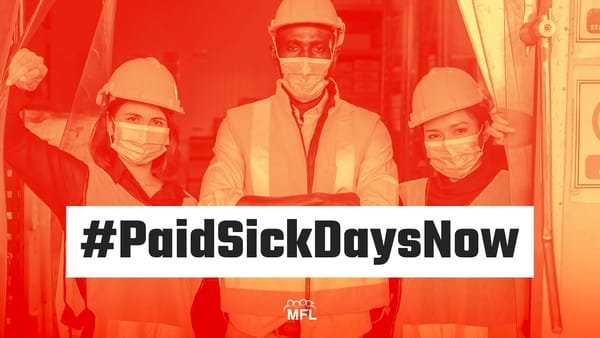
For the first three weeks of November, educational assistants (EAs) employed by the Hanover School Division (HSD) in Steinbach, Man., were on strike.
In many respects, the strike looked like numerous others across the country over the past two years: underpaid and undervalued public sector workers hitting the picket line to demand fairer wages and better working conditions.
But this wasn’t a typical work stoppage by unionized educators. Rather, the EAs are members of the Christian Labour Association of Canada (CLAC), a controversial organization that the rest of the labour movement in Canada considers a “company union” that openly collaborates with employers to undermine and undercut “real unions.”
Shockingly, as far as I can tell, no local or national media outlet covering the strike discussed CLAC’s orientation or its contested position in the constellation of Canadian labour politics. Instead, media ranging from local newspapers to the CBC simply treated CLAC like any other union.
Those on the labour beat missed an opportunity to delve into CLAC’s controversial past and present actions. But in an important sense, failing to contextualize CLAC buried the lead on the story of striking EAs in Steinbach. How did a group of 300 education workers come to be members of this “company union” and how did they end up on the picket line when their “union” openly opposes strikes?
Without interviewing members, it’s difficult to fully answer these questions. But by looking at some of CLAC’s history, we can get a sense of both why the organization’s history and orientation matter and just how uniquely strange this strike was.
Company, Religious or Populist Union?
CLAC has been a thorn in the side of the labour movement since its founding by Dutch immigrants in 1952. In key respects, it stands opposed to most everything that labour holds dear. The Christian group proudly touts its accommodationist approach with employers, opposes the “closed shop” and openly commits to avoiding strikes at all costs.
As the Canadian Labour Congress (CLC) put it in a “fact sheet” about CLAC from some years ago: “CLAC’s primary goal is to undercut the work of legitimate, democratic and truly representative unions and to roll back the clock on gains made over decades. All this in the name of creating a positive relationship with antiunion employers, who are eager to keep real unions out.”
In general, as Steven Tufts and Mark Thomas explain, CLAC pursues an “accommodationist” approach with employers that typically involves “negotiating” wages and benefits below industry standards and preventing real union certifications.
While many unions can at times be “accommodationist” by, for example, limiting their economic demands to secure employer investment and job creation, the CLAC has historically pursued a much deeper form of accommodation that eschews conflict entirely and instead openly seeks collaboration with employers, often undercutting and undermining legitimate unions in the process.
In provinces where it has members — Ontario, Manitoba, Saskatchewan, Alberta and British Columbia — CLAC has brazenly antagonized unions by signing sweetheart deals with employers to keep competitor labour organizations out, often without the direct input of the workers impacted. For example, anti-union grocer Save on Foods worked with CLAC in B.C. to prevent workers from organizing with the United Food and Commercial Workers.
In this sense, CLAC’s project has been one of securing jobs for its members at the expense of both other unions and their members and the broader bargaining power of the organized working class in the regions where it operates.
However, CLAC is not simply a ‘company union’ or an independent union that seeks collaboration with employers; it is also a quasi-religious organization, as its name suggests. In fact, as Adam Cywinski argues, the CLAC has used its understanding of social gospel and Christian altruism to recruit among healthcare workers in Ontario. This strategy has borne some fruit, particularly among those delivering privatized forms of care in nursing homes and home health care.
This perhaps explains, at least in part, how CLAC came to represent workers in Steinbach, a region with a strong religious tradition and a large Mennonite population.
As Tufts and Thomas further explain, however, CLAC has also deployed the language of populism in its recruitment and expansion strategy, making its approach challenging for unions and the left to rebut. The organization frequently challenges unions, such as those in construction, as well as public sector unions, thought to be representing an “elite” of workers or harming “taxpayers.”
Given CLAC’s collaborationist orientation and seemingly congenital aversion to labour conflict, to say that it was surprising to see a striking education local is an understatement. Indeed, as Geoff Dueck Thiessen, CLAC’s Winnipeg regional director and representative, said when EAs at HSD first walked off the job: “CLAC prefers to represent our members in a partnership with employers, and we rarely strike. In this case, it’s the right thing to do. We hope to resolve this as quickly as possible and get these folks back to work with a wage they can live on and that respects their efforts.”
CLAC in the Political Arena
Although CLAC emphasizes its non-partisanship — a critique of the CLC’s relationship with the NDP — it is not above working with right-wing political forces on shared issues of concern.
For example, the Christian labour group has entered agreements with and supported the anti-union campaigns of right-wing provincial governments in Ontario and B.C., particularly where this has involved attacking construction unions. It has taken particular aim at community and project benefit agreements, whereby governments commit to employing union labour on development projects receiving public funds.
As one example, CLAC supported Bill 73, the Fair and Open Tendering Act of 2013, a law tabled by a Progressive Conservative MPP in Ontario that sought to “close a loophole” whereby municipalities contracted exclusively with unionized firms. Conservative proponents of the bill could claim that it had the backing of construction firms and associations, as well as “unionized contractors” (i.e., CLAC).
A similar effort was undertaken in B.C. aimed at undermining union representation and wages on public infrastructure projects. CLAC has also more recently partnered with and received funding from the Doug Ford government in Ontario to provide training in the construction sector.
During such efforts to de-regulate construction contracting, CLAC will commonly work with affiliated employer associations and right-wing think tanks to produce “research” claiming that the “construction monopolies” and unions inflate the cost of building and thus harm taxpayers.
From Tufts and Thomas again: “For accommodationist unions […] partnering with anti-worker governments is a necessary political strategy. The state is not something to be ignored or bypassed, but something necessary to co-opt if accommodationist unions are to replace more traditional labour unions in regulated sectors such as commercial construction.” The construction industry has been a prime target for CLAC, as a history of business unionism focused on economic growth and some partnership with employers on the part of traditional construction building trades unions has made the sector more susceptible to CLAC’s inroads.
On the other hand, the Christian “union” found itself in the strange position of contending with replacement workers when it came to light that the HSD was advertising to hire scabs during the recent strike. While careful not to endorse the Manitoba labour movement’s call for anti-scab legislation from the newly elected provincial NDP government, it ended its press release by noting that such legislation is under consideration. This episode was somewhat humorous given that CLAC supports an “open shop” and opposes “forced union membership.”
Making Sense of the CLAC EA Strike
The CLAC has greatly expanded its membership over the past couple of decades. Although Ontario and B.C. are the organization’s strongest bases of members, it has also recruited and set up sizable bargaining units in other provinces, including Manitoba. For some years, it has claimed to represent more than 60,000 workers across Canada.
As should be clear, this expansion has been hotly contested by Canadian labour. In 2011, the CLC requested that the International Trade Union Confederation (ITUC) suspend CLAC over the latter’s collaborationist approach with employers and its undermining of established trade union rights, which the ITUC obliged. Before and after the ITUC decision, CLAC raided CLC-affiliated unions in healthcare and construction. CLAC later joined the World Organization of Workers, an international Christian labour federation similarly committed to collaboration with employers, and remains committed to its strategy of raiding and undermining legitimate unions.
CLAC’s collaborationist message over many decades has emphasized an aversion to strikes. Indeed, for many years the organization’s slogan was “a union that works” — a play on CLAC’s supposed bargaining efficiency and its commitment to avoiding strikes. To uninitiated workers, the prospect of union representation, and the gains that come with it, without the risk of job action may have some appeal. This is why the case of EAs in Steinbach is all the more interesting.
It appears that the HSD sought to employ EAs at a discount, an arrangement familiar to CLAC. Yet, given that education is a highly unionized sector, with the Canadian Union of Public Employees (CUPE) the overwhelming choice for workers in similar jobs elsewhere, CLAC’s typical strategy seems to have come up short. Had CLAC not supported EAs’ efforts to fight for higher wages, these workers could have theoretically decertified and organized with CUPE.
As Tufts further explained to Class Struggle: “The CLAC model only works in sectors that are low wage, with significant non-union workers where employers can use CLAC as ‘real union’ avoidance. It doesn’t work in public sectors with high union density and clear jurisdiction because CLAC can’t deliver in the long term. This might be one of those cases.”
Educational assistants at HSD are now returning to work after securing wage increases, of how much we don’t know (CLAC is tight-lipped about contract details, too). Without a doubt, these workers deserve the raise — but let’s hope they get themselves a real union before the next bargaining round.
Recent Class Struggle Issues
- November 20 | Canada’s Top 0.01% Saw Income Growth Of 30% In 2021
- November 13 | The Federal Ban On Scabs Is A Major Victory For Labour
- November 6 | Striking Seaway Workers Showed The Power Of ‘Essential’ Labour
- October 30 | Canadian Labour Is Lining Up In Support Of Palestinians








Member discussion